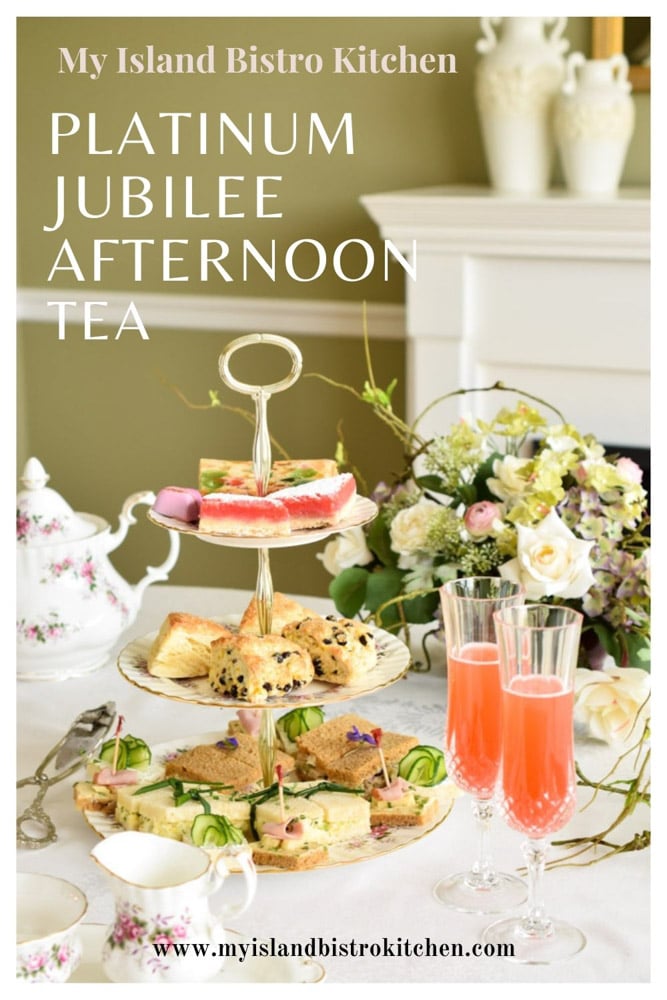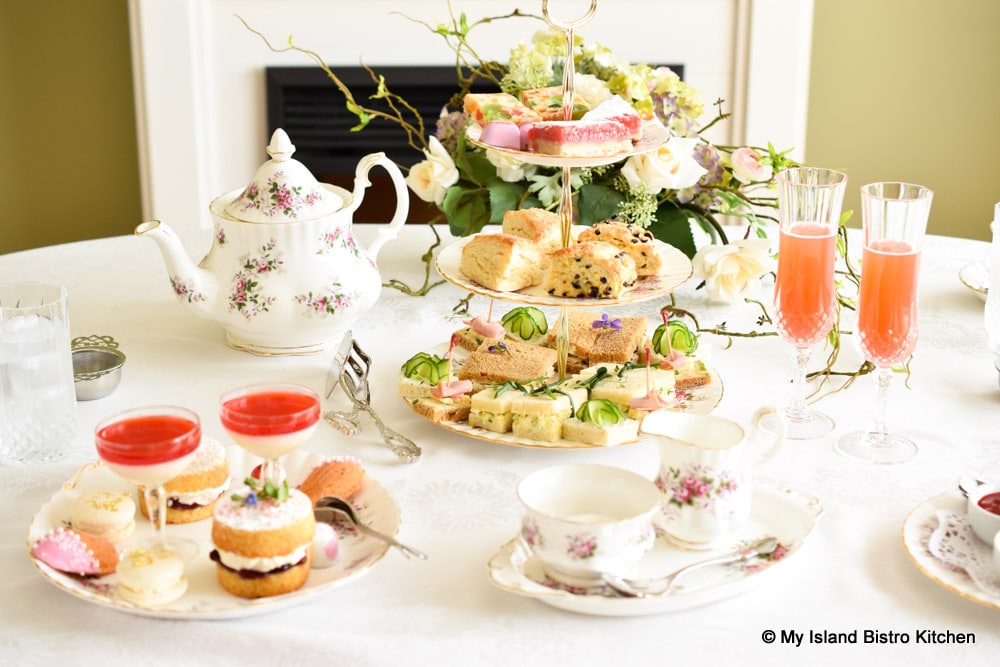
Today, we enjoyed a Celebratory Platinum Jubilee Afternoon Tea. It’s not many people who can say they worked in the same job for 70 years and probably even fewer can boast of still being on the job every day with plans to continue! As I write this post, it is June 2, 2022, the actual 70th anniversary of the formal coronation of Her Majesty Queen Elizabeth II (now aged 96) which took place on June 2, 1953.
There are many celebrations scheduled to mark this historic event, including Platinum Jubilee Afternoon Tea events in the United Kingdom – London in particular, and indeed throughout parts of the Commonwealth. While I would like to have been in London for this weekend and would have enjoyed one or more festive Platinum Jubilee afternoon teas at some of my favorite places as well as new ones to be discovered, the next best thing was to host a Celebratory Platinum Jubilee Afternoon Tea at home!
I thought blog followers might be interested in having a look at my version of a Platinum Jubilee Afternoon Tea. So, make yourself a cuppa and I’ll tell you what was on my menu.
First, I must say I do not have recipes published for every food item seen on the tea table but, for those for which I do have published recipes, I will put the hotlinks into the text for easy access to the recipes available on my website.
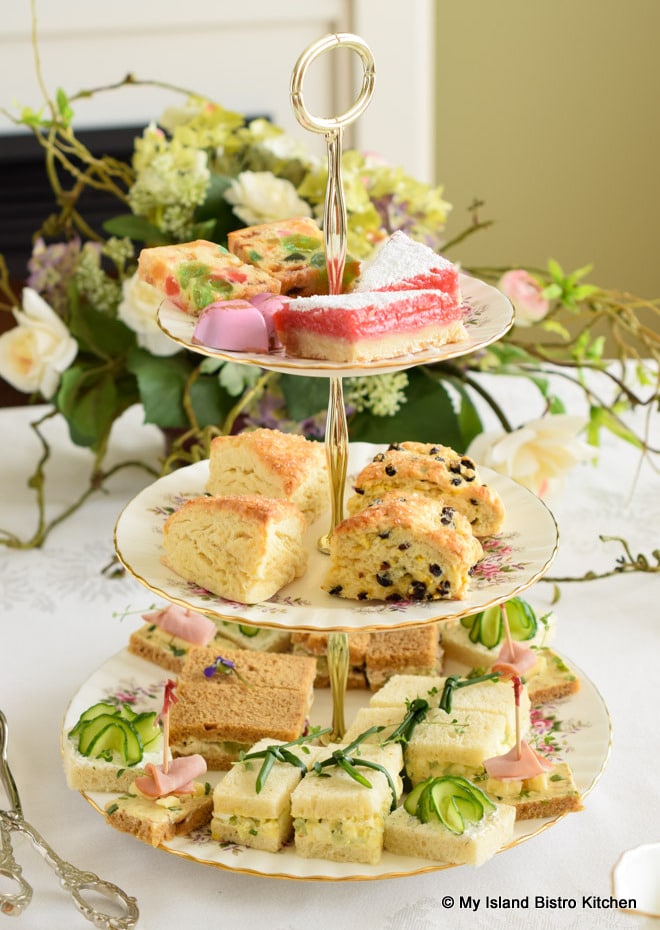
As many of you who are regular followers of my food blog know, I simply adore afternoon teas! Today, my Platinum Jubilee Afternoon Tea was actually a Royal Afternoon Tea to celebrate Her Majesty’s long career so it was more formal than my usual afternoon tea events. There are two elements that made this a more formal event. For starters, I used my good china, all matching pieces. Often times, I will use mismatched, but still curated and coordinated, cups, saucers, and other china pieces for afternoon tea events but, when it is a formal event, everything should match, including glassware and cutlery.
The second element that elevated this event from a standard afternoon tea to what would be classified as a Royal Tea was the inclusion of a sparkly drink. Champagne is the usual choice though Prosecco may also be served. Sometimes, this version of an afternoon tea is simply called a Champagne Tea.
With a Royal Afternoon Tea, all the elements of a typical Afternoon Tea (i.e., sandwiches, scones, and desserts) are still included. For my Royal Afternoon Tea today, I served Italian Mionetto Prosecco with a splash of my Rhubarb Strawberry Cordial. How colorful and summery was this pretty drink to start off our afternoon tea and raise a glass to Her Majesty!
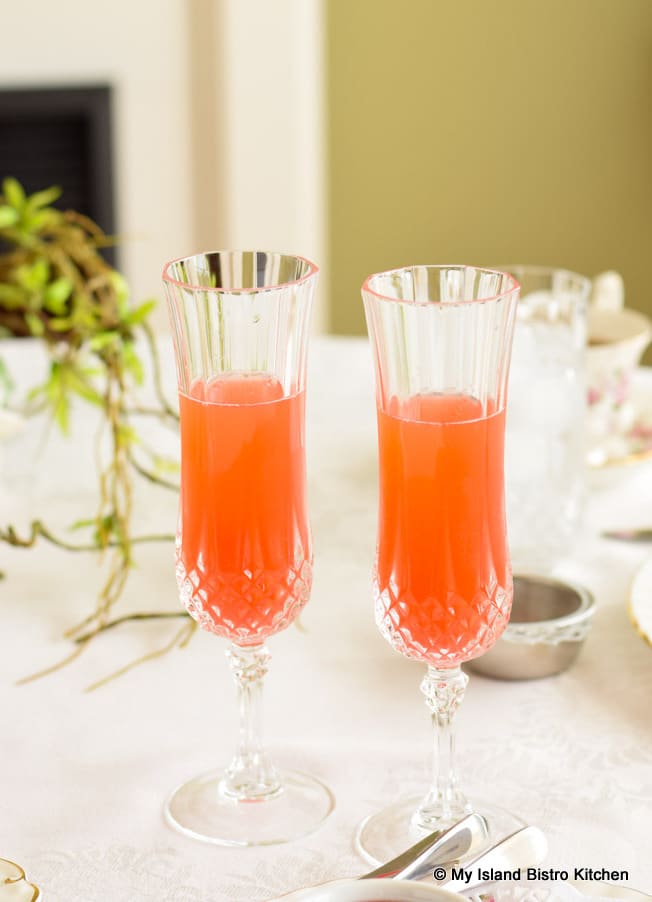
The Table
My china pattern is Royal Albert’s Lavender Rose. I love it as much today as when my mother started me on my first four-place settings many years ago so it was actually quite a joy to use pieces of the collection for a special commemorative afternoon tea. Because pink is the primary color of the china pattern, pink also became a significant color theme to my afternoon tea.
The table was set with an antique linen tablecloth and the napkin fold I chose was the simple “wave” fold. Often, with formal tablesettings, I will opt for a classic, understated napkin fold and simple white linens so as not to detract from the food and china used.
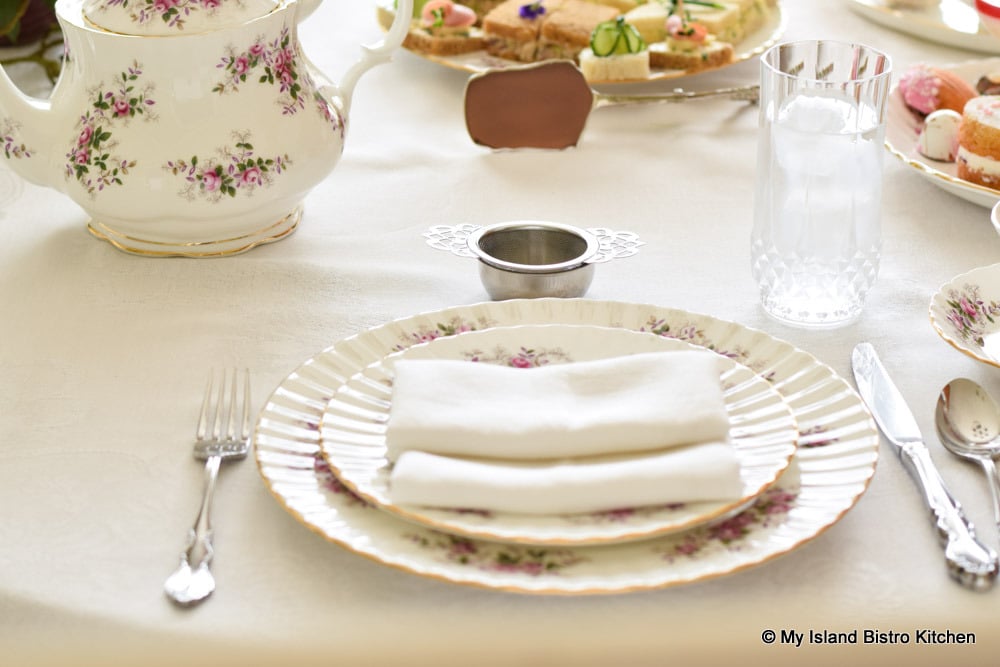
The Menu
My menu for this three-course afternoon tea was inspired by: 1) Fare typical of a British afternoon tea; 2) Seasonal ingredients local to my region; 3) Flavor compatibility; and 4) Color coordination.
Food items were served on a classic three-tier server and the food was consumed in the traditional sequential order. That is to say, sandwiches were eaten first, followed by the scones course, and ending with dessert and sweets. So, with the standard order of food consumption at an afternoon tea, guests work their way from the bottom plate to the top. Afternoon tea events are intended to be leisurely and unhurried, often taking 2-3 hours, giving guests time to fully enjoy the fare and linger over conversation.

Sandwich Course
We started off with a selection of four kinds of delicate sandwiches. I usually figure on three to five different kinds of sandwiches. It goes without saying that, for any kind of afternoon tea event, the sandwiches must be completely crustless and sized into shapes about two to three bites each.
A proper afternoon tea is a refined event and sandwiches are intended to be dainty, elegant, and very neat and tidy. To achieve this objective, the removal of the dark, bulky bread crusts is a must. The filling should not look messy or sloppy and there should be no evidence of the filling oozing out of the sandwich. For this reason, use care when adding mayonnaise to a sandwich filling as the filling can quickly become soupy and runny and leave a messy sandwich for a guest to deal with. It is best to leave the crusts on the bread while making the sandwiches then slice them off after assembling the sandwiches. That way, the sandwiches will have perfectly straight edges and a lovely clean, neat appearance.
I find teatime sandwiches do best on bread that is somewhat dense and can hold its shape well when picked up and not squish flat or have the filling ooze out when picked up in the fingers.
Sandwiches for an afternoon tea event can be made a few hours ahead, covered with a lightweight damp tea towel to keep them moist, and refrigerated until serving time.
I like to include open-faced sandwiches in the sandwich course in addition to the typical finger sandwiches. Including a variety of sandwich types and shapes lends variety and interest to a sandwich plate.
Today, I served four kinds of sandwiches. The first is the traditional egg salad sandwich on my homemade white bread. You can find the egg salad filling recipe here. These sandwiches are in the typical finger style and are dressed with fresh chives and a sprig of thyme.
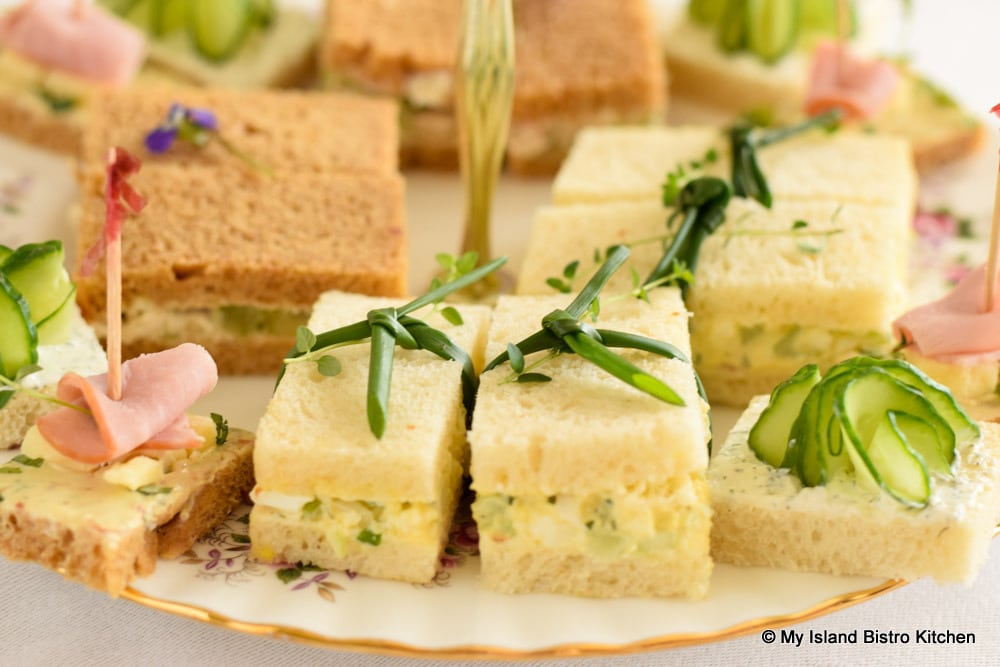
The second finger sandwich is my version of the famous teatime sandwich known as the Coronation Chicken Sandwich and is presented on homemade whole wheat bread. Did you know that the Coronation Chicken Sandwich (originally called “Coronation Elizabeth”) was created by two women at the Cordon Bleu Cookery School especially for the Queen’s 1953 Coronation? Seventy years later and versions of the Coronation Chicken Sandwich still regularly appear on teatime menus.
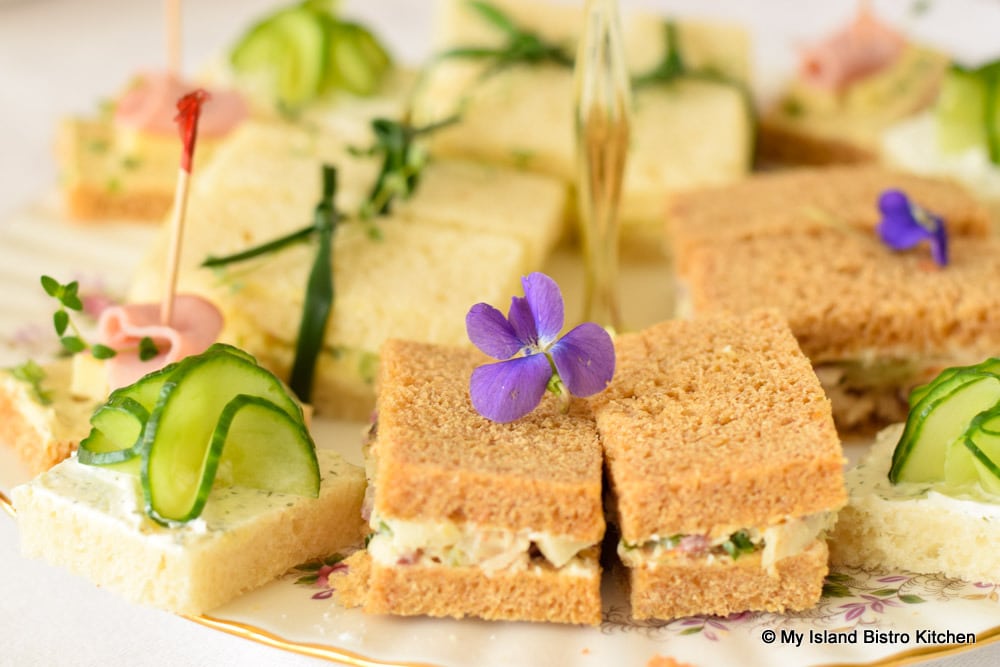
No afternoon tea would be complete without the quintessential cucumber sandwich which, today, is in open-faced style on white bread. The spread on this sandwich is cream cheese mixed with some fresh dill.
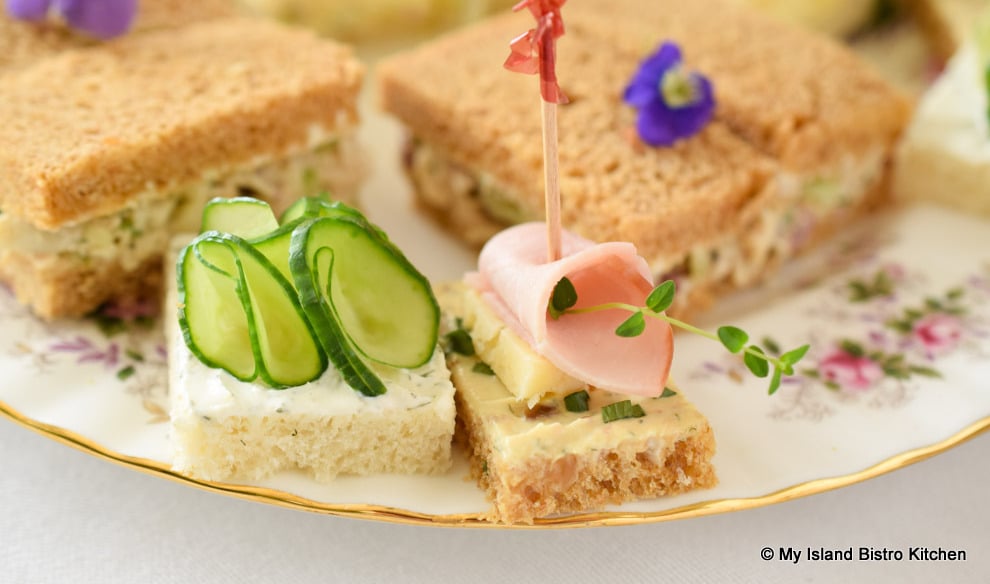
Finally, the open-faced Ham and Guyère sandwich is presented on whole wheat bread atop a spread of mayonnaise, fig jam, and honey mustard. A sprig of thyme garnishes the sandwich.
Scones Course
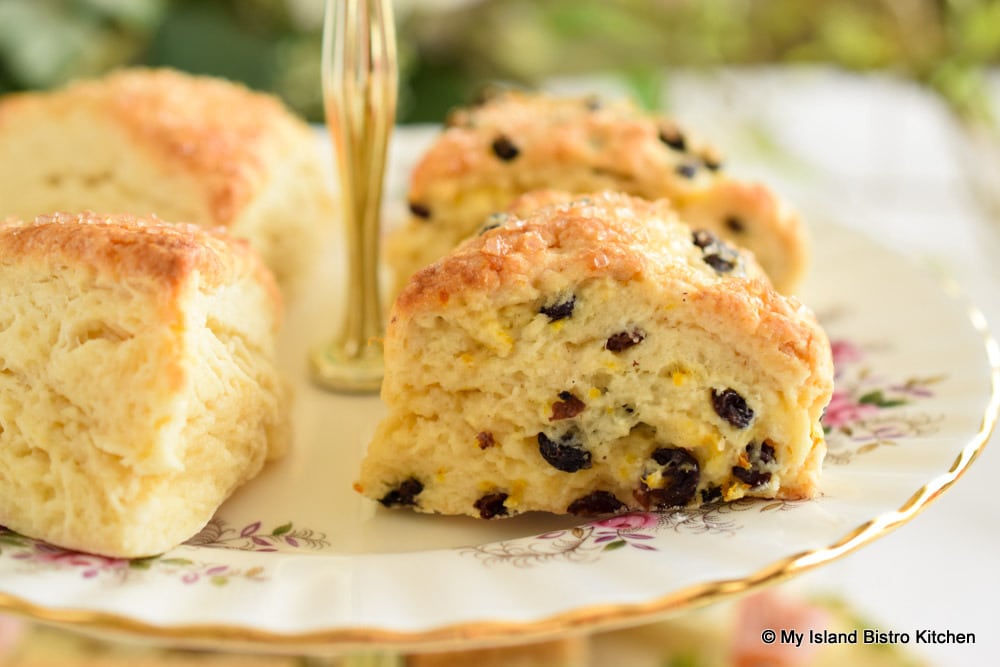
Scones and afternoon tea are synonymous! Today, I had two kinds of scones on the tea table – Currant and Orange Scones and Plain Scones, all still warm from the oven. Depending on their size, I usually figure one to two scones per person. You can find my scone recipe here and my tutorial for How To Make Scones here. Can you see the layers of buttery flakiness in these puffy, toothsome scones! A knife should never be needed to break apart a scone. Rather, like these scones, they should be light and flaky enough that they break apart easily with the hands.

In addition to the Devonshire Double Cream, I offered two scone toppings – my Strawberry Rhubarb Freezer Jam and my homemade Lemon Curd. I like to place the small bowls of scone toppings on a plate or tray for ease of passing between teatime guests. I consider that these should be passed together as a group (just as would be done with a set of salt and pepper shakers), rather than individually and risking spillage or having them become orphaned.
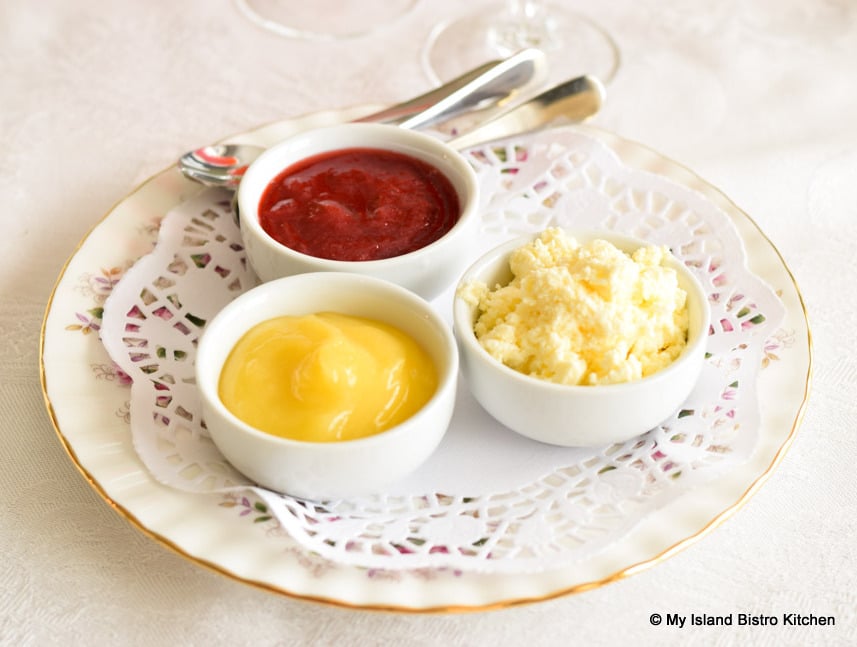
Dessert Course
The top tier of an afternoon tea server is reserved for the sweets and pastries.
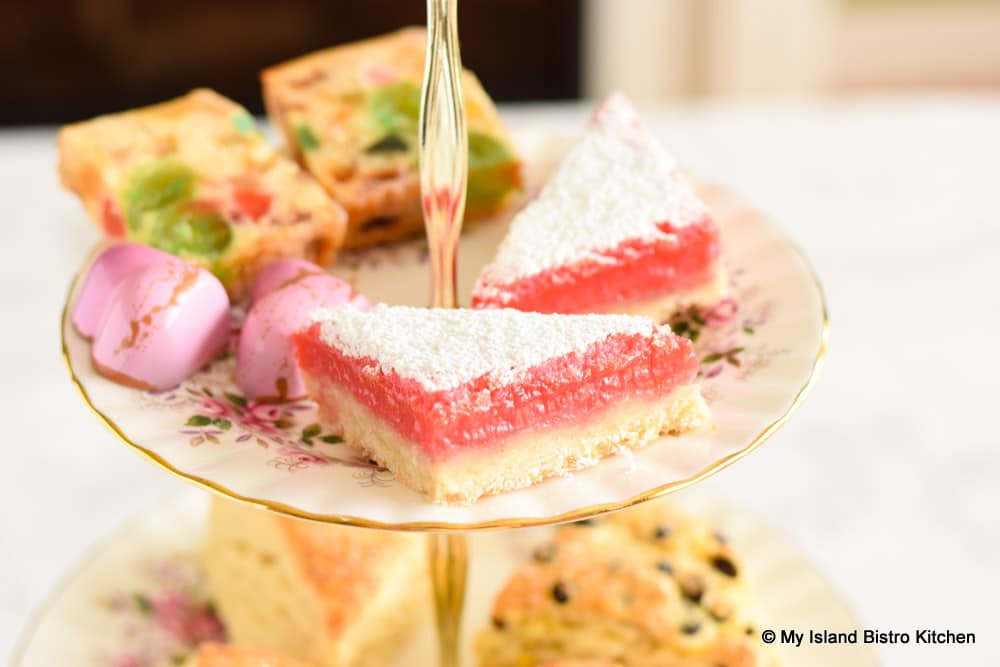
However, that top plate is very small and I had more items than would fit on the small dessert plate so I used my large cake plate to hold and display two signature desserts in addition to some other dainty and delicate sweets.

I couldn’t have a Royal Platinum Jubilee Afternoon Tea without including the classic Victoria Sponge Cake (aka Victoria Sandwich), a long-time traditional teatime cake. You can find my recipe for the Victoria Sponge Cake here. For today’s tea table, I made small, individual versions of the cake filled with jam and chantilly cream.
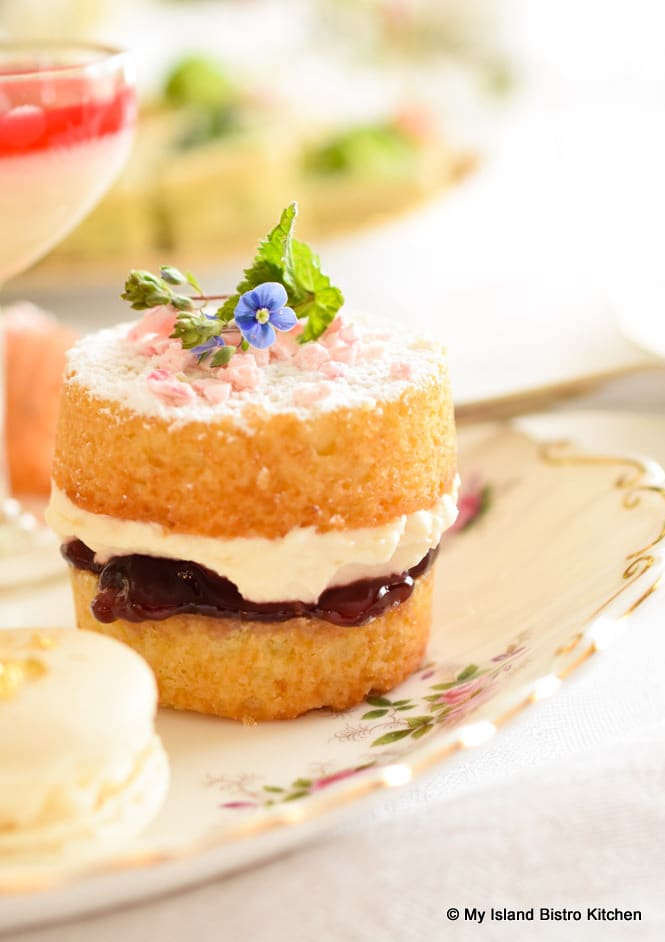
When everything on a tea table is small and dainty, I think it justifies increasing the number of desserts (or, at least, that’s the story I am sticking to!)

My second signature dessert was Panna Cotta with a strawberry rhubarb gélee. My recipe for basic Panna Cotta is accessible here. This dessert was presented in very small dainty glass pedestal dessert dishes which allowed the layers of the Panna Cotta to be visible.

French Macarons are always a lovely addition to a tea table and, today, mine were regally decorated in 24-kt edible gold for the occasion.

Tiny Cherry Madeleines in their iconic shell shape were dipped in pink chocolate and decorated in pearl dragées as a nod to the Queen’s signature pearl necklace we often see her wearing.
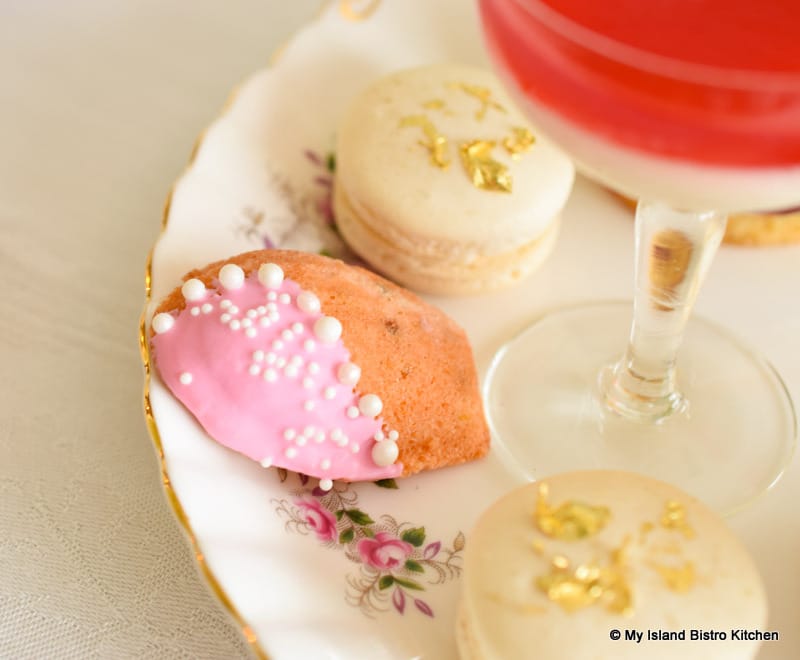
Fruitcake is a British tradition and I would be remiss not to include it in my afternoon tea fare. My light fruitcake was on today’s tea table. You can find my recipe for light fruitcake here and for my gluten-free light fruitcake here.
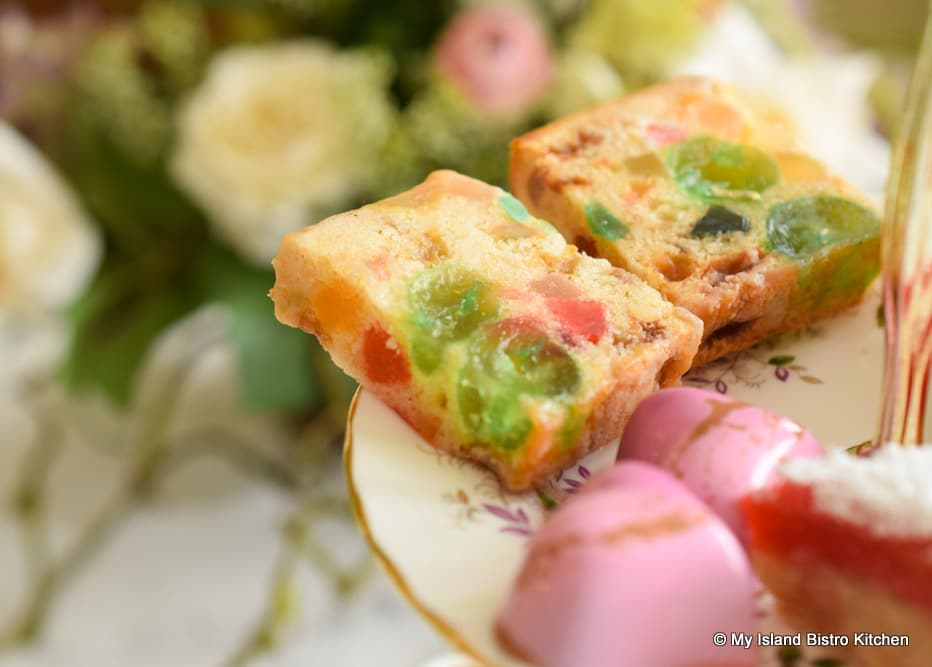
I have also included my Strawberry Rhubarb Bars on today’s dessert plate. These showy and scrumptious Bars feature a rich buttery shortbread crust with a luscious strawberry rhubarb topping. You can find my recipe for these Bars by clicking here.

The lovely chocolates seen on my dessert plate today were artisan chocolates made by Jane and Sue Chocolates in Stanley Bridge, PEI. Their attention to detail and confectionery work are exquisite and their shop is well worth a visit. I just knew they would have decadent chocolates that would coordinate with my color scheme and they did not disappoint! Aren’t these confections just stunning!
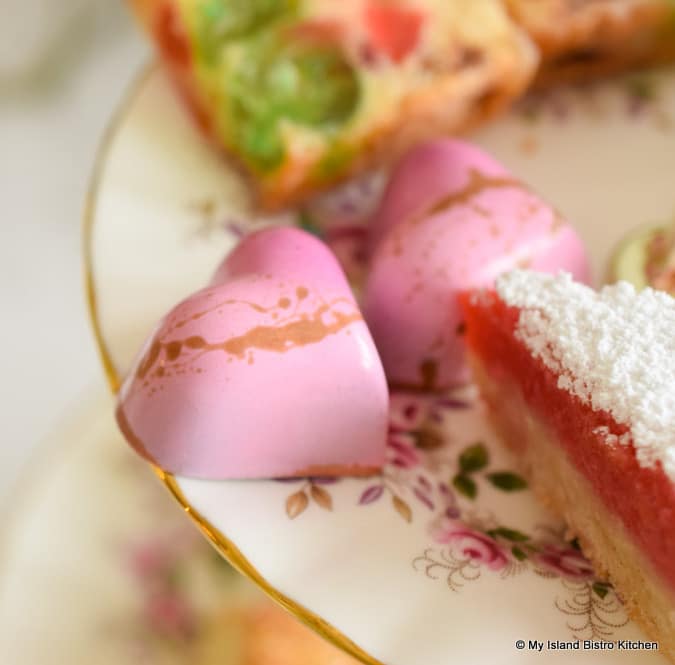
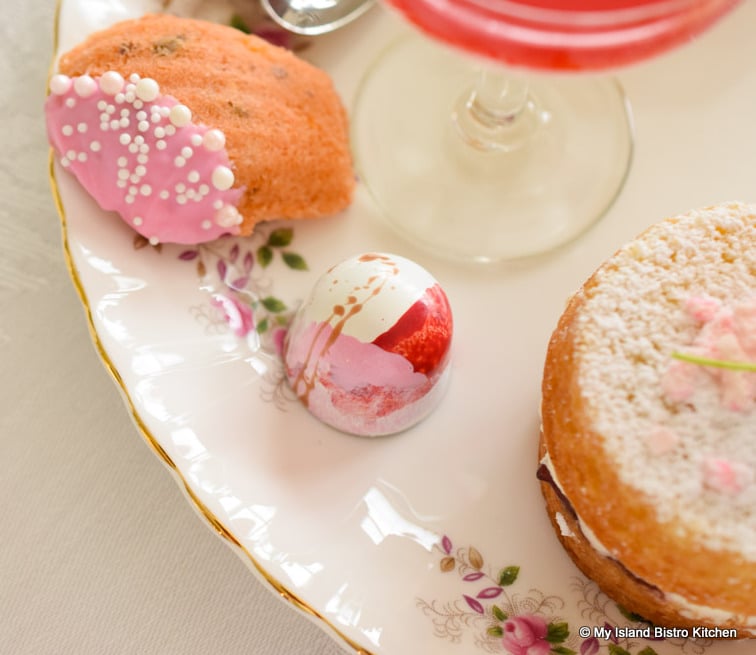
Tea Pairings
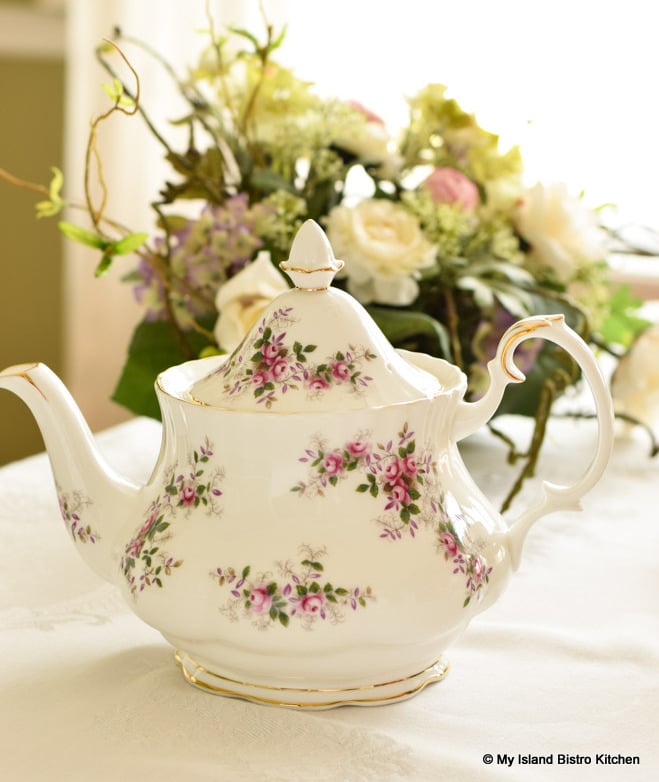
Today, I prepared three separate pairings of tea, a different one for each course of the afternoon tea. The teapot in the photo above is the one from my Royal Albert china. The teacups from my china set are in the Montrose shape. This shape is very characteristic of fine bone china cups and saucers, particularly from Royal Albert which first introduced the shape in 1962 with their now-famous Old Country Roses pattern.

We are black tea drinkers and don’t personally like flavored teas so we started off with Happy Elephant’s Himalayan Darjeeling, an aromatic light-bodied tea, for the sandwich course. Tea pairing for the scones course was Twinings’ Earl Grey Tea. With its citrus notes, it was an excellent pairing, particularly with the scones that contain a hint of orange flavor. And, for the dessert course, the selection was Happy Elephant’s English Afternoon Tea.
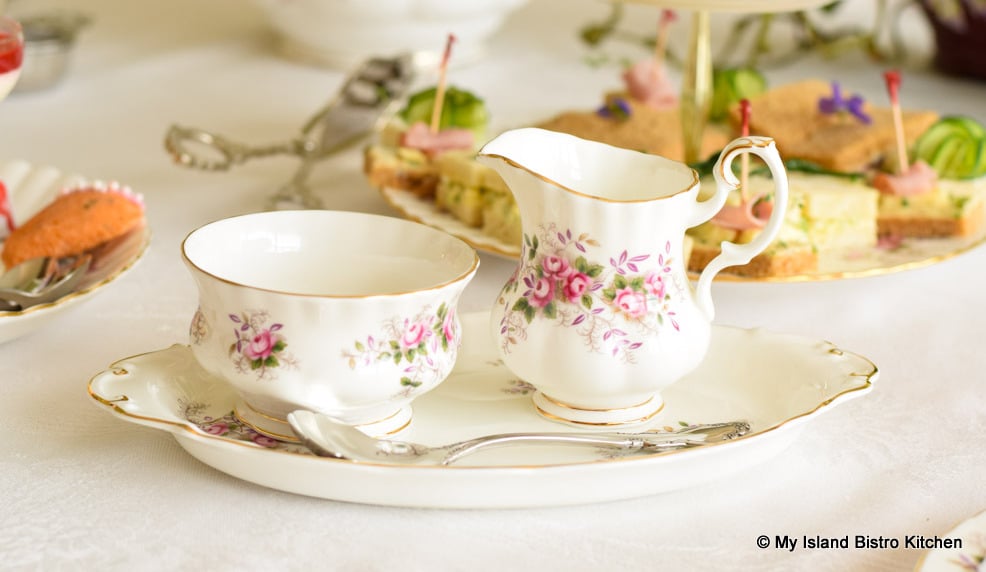
I hope you have enjoyed a glimpse into my Celebratory Platinum Jubilee Afternoon Tea.
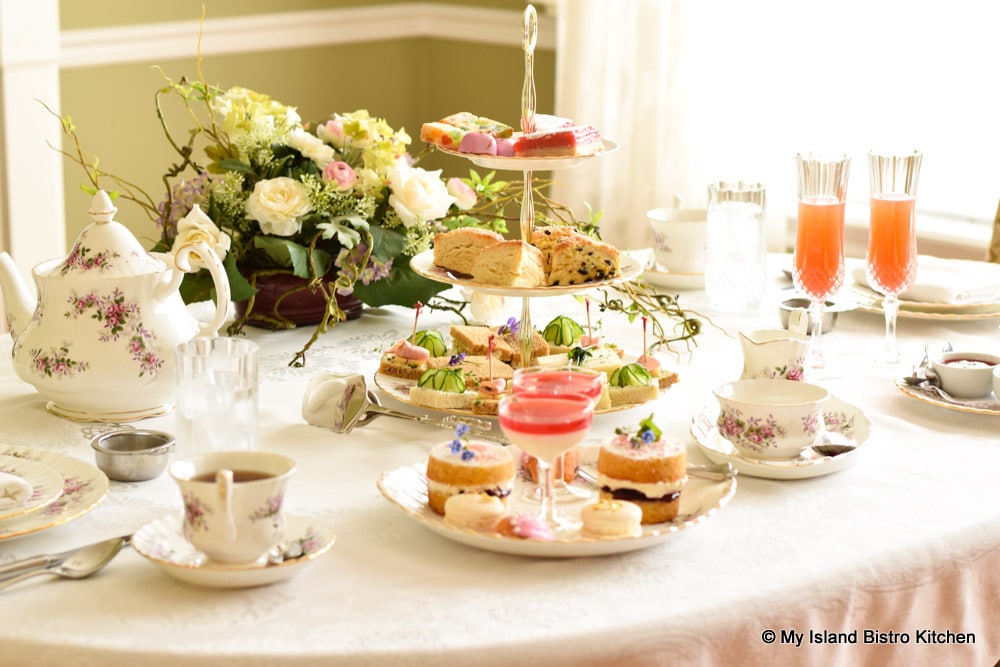
Be sure to check out my previous Afternoon Tea events by going to the Afternoon Tea section from the menu bar on my home page.
Connect with My Island Bistro Kitchen by:
Joining the Facebook page for My Island Bistro Kitchen: https://www.facebook.com/MyIslandBistroKitchen/
Following “the Bistro” on Twitter: https://twitter.com/PEIBistro/
Seeing the drool-worthy gallery of mouth-watering food photos from My Island Bistro Kitchen on Instagram: https://www.instagram.com/peibistro/
Following “the Bistro” on Pinterest at https://www.pinterest.ca/peibistro/
(and you can pin the Pinterest-ready photo at the end of this posting to your favorite Pinterest boards)
PIN ME TO PINTEREST!
